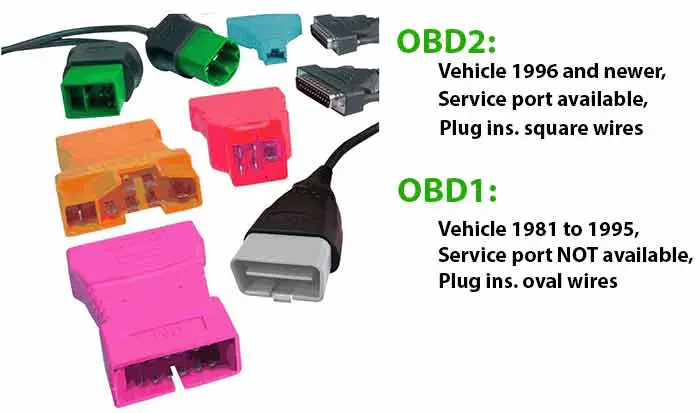Last Updated on September 6, 2025

When it comes to understanding vehicle diagnostics, two terms often come up—OBD1 and OBD2. These systems, short for On-Board Diagnostics, play a vital role in keeping your car in good shape. They allow mechanics and car owners to identify engine problems, monitor performance, and prevent costly breakdowns before they happen.
OBD1 was the first generation of this technology, appearing in the 1980s and widely used until 1996. It gave car manufacturers a way to check for errors, but each brand had its own version, making it complicated to use across different vehicles. On the other hand, OBD2 became mandatory for all vehicles sold in the U.S. from 1996 onward. It offered standardization, a universal connector, and far more powerful diagnostic capabilities.
In short, if you are comparing OBD1 vs OBD2, the modern OBD2 system is the clear winner. It is faster, more reliable, and much easier to use than its predecessor. Whether you are a professional mechanic or a DIY car owner, OBD2 scanners are now considered the industry standard for troubleshooting and monitoring vehicle health.
What is OBD, OBD1, and OBD2?
The term OBD stands for On-Board Diagnostics. It is an electronic system built into vehicles that constantly monitors the health of the engine, emissions, and other important systems. When something goes wrong, the OBD system records an error code and communicates it through a diagnostic port. Mechanics or car owners can then connect a scanner to this port to read the codes and identify the problem.
The first generation, known as OBD1, was introduced during the 1980s. While it represented a big step forward in automotive technology, it came with major limitations. Each manufacturer developed its own version of OBD1, which meant that diagnostic codes were not standardized. In practice, this made it confusing and inconvenient because a scanner that worked on one car brand would not necessarily work on another.
By contrast, OBD2 became a game-changer. From 1996 onward, all vehicles sold in the United States were required to have OBD2 systems. Unlike OBD1, OBD2 uses a universal 16-pin connector and follows standardized fault codes. This makes diagnostics easier, faster, and consistent across all brands and models. Beyond just reading error codes, OBD2 also provides live sensor data, advanced reporting, and even compatibility with smartphones and apps.
Key Differences Between OBD1 and OBD2
Although both OBD1 and OBD2 were designed to detect issues in vehicles, the differences between them are significant. One of the most important distinctions lies in the manufacturing date. OBD1 was typically installed in vehicles built before 1996, while OBD2 became mandatory for all cars sold in the United States from 1996 onward. If your car is newer than that, it almost certainly uses OBD2.
The diagnostic power of these systems also sets them apart. OBD1 could only provide basic error codes, and those codes often varied from one manufacturer to another. This meant that the information was limited and sometimes difficult to interpret. OBD2, however, offers far more detailed data. It can track live engine performance, fuel trim levels, sensor activity, and even monitor emissions in real time, making it much more reliable.
Accessibility is another major difference. OBD1 ports were placed in inconsistent locations, sometimes under the hood or hidden in hard-to-reach spots. OBD2 solved this problem by introducing a standard 16-pin connector, almost always located beneath the dashboard on the driver’s side. This consistency makes it easier for anyone—whether a mechanic or a car owner—to plug in a scanner without searching for the port.
Reliability and standardization are also worth noting. OBD1 relied on manufacturer-specific codes and software, which created confusion and required multiple tools. OBD2 unified the process with standardized codes, meaning a single scanner can now work on virtually all modern vehicles. Combined with user-friendly interfaces and the ability to connect via Bluetooth or Wi-Fi, OBD2 has made vehicle diagnostics more accessible than ever before.
Advantages and Disadvantages
When comparing OBD1 and OBD2, it quickly becomes clear why OBD2 is the standard in modern vehicles. The advantages of OBD2 are numerous. It provides a universal system that works across all car brands, thanks to standardized fault codes. This means you no longer need a different tool for each manufacturer. OBD2 also goes beyond simple error reporting, offering live data such as fuel efficiency, air–fuel ratios, sensor activity, and even real-time performance monitoring. Many OBD2 scanners now connect via Bluetooth or Wi-Fi, allowing drivers to view data directly on their smartphones through user-friendly apps. Regular firmware updates also ensure compatibility with newer models, making OBD2 scanners future-ready.
OBD1, by contrast, had many drawbacks. Its lack of standardization made it frustrating to use, as every manufacturer developed its own version. The diagnostic information was limited and often cryptic, requiring brand-specific scanners and specialized knowledge to interpret the codes. With OBD1, keeping track of performance or troubleshooting problems was time-consuming and inconvenient, and today it is even harder to find replacement parts or support for this outdated system.
That said, OBD2 is not without its own challenges. High-quality scanners with advanced features can be expensive, which might discourage casual car owners from investing in them. On the other hand, very cheap OBD2 tools may lack depth in their reporting and fail to provide accurate real-time data. Some models also require mobile apps or internet access, which may not appeal to everyone.
Feature Comparison Between OBD1 and OBD2
The real difference between OBD1 and OBD2 becomes clear when you look at how each system handles diagnostics. OBD1 relied on manufacturer-specific codes, so the meaning of an error often changed depending on the brand. OBD2 solved this by introducing universal, standardized fault codes that work across all makes and models.
When it comes to the type of information provided, OBD1 offered only the most basic error codes, which didn’t give much detail. OBD2, on the other hand, delivers live sensor data—from RPMs and throttle position to fuel trim levels and temperature readings—allowing drivers and mechanics to pinpoint issues more precisely.
Compatibility is another major factor. OBD1 tools were tied to specific vehicles, meaning you needed different scanners for different brands. OBD2 changed that by introducing universal scanners that work with virtually every car manufactured after 1996.
The user experience has also improved dramatically. OBD1 relied on outdated, hardware-based tools that were often difficult to use. OBD2 scanners are far more user-friendly, with mobile apps, easy-to-read interfaces, and wireless connections through Bluetooth or Wi-Fi. These scanners are also designed to receive regular updates, ensuring they stay useful for years, even as new car models are released.
Even accessibility has been standardized. While OBD1 ports were sometimes hidden under the hood or in hard-to-reach areas, OBD2 uses a 16-pin connector located beneath the dashboard, usually within easy reach of the driver’s seat. This consistency has made diagnostics faster and more convenient.
Feature Comparison Between OBD1 and OBD2
The real difference between OBD1 and OBD2 becomes clear when you look at how each system handles diagnostics. OBD1 relied on manufacturer-specific codes, so the meaning of an error often changed depending on the brand. OBD2 solved this by introducing universal, standardized fault codes that work across all makes and models.
When it comes to the type of information provided, OBD1 offered only the most basic error codes, which didn’t give much detail. OBD2, on the other hand, delivers live sensor data—from RPMs and throttle position to fuel trim levels and temperature readings—allowing drivers and mechanics to pinpoint issues more precisely.
Compatibility is another major factor. OBD1 tools were tied to specific vehicles, meaning you needed different scanners for different brands. OBD2 changed that by introducing universal scanners that work with virtually every car manufactured after 1996.
The user experience has also improved dramatically. OBD1 relied on outdated, hardware-based tools that were often difficult to use. OBD2 scanners are far more user-friendly, with mobile apps, easy-to-read interfaces, and wireless connections through Bluetooth or Wi-Fi. These scanners are also designed to receive regular updates, ensuring they stay useful for years, even as new car models are released.
Even accessibility has been standardized. While OBD1 ports were sometimes hidden under the hood or in hard-to-reach areas, OBD2 uses a 16-pin connector located beneath the dashboard, usually within easy reach of the driver’s seat. This consistency has made diagnostics faster and more convenient.
In short, OBD2 outperforms OBD1 in almost every category: reliability, compatibility, ease of use, and the depth of diagnostic data it provides.
Final Verdict
When choosing between OBD1 and OBD2, the answer largely depends on the age of your vehicle. If you own a car manufactured before 1996, you may still need OBD1, although compatible scanners can be difficult to find today. For any vehicle built in 1996 or later, OBD2 is the clear and obvious choice. It is more reliable, provides detailed real-time data, and works across all car brands with a single universal scanner. For professional mechanics and even casual DIY car owners, investing in a good OBD2 scanner is almost essential in 2025.
The final verdict in the OBD1 vs OBD2 debate is simple: OBD2 wins. It offers better standardization, faster results, broader compatibility, and far greater ease of use. Whether you’re diagnosing a check engine light or monitoring fuel efficiency, OBD2 provides the tools you need to keep your vehicle safe, efficient, and road-ready.
Frequently Asked Questions
Can I use an OBD2 scanner on an OBD1 car?
No. OBD2 scanners are not directly compatible with OBD1 vehicles. However, some specialty tools and adapters are available that support both systems, depending on the make and model.
Which is better: OBD1 or OBD2?
OBD2 is better in every key aspect. It provides accurate diagnostics, supports live data monitoring, and is far more user-friendly and compatible than OBD1.
What vehicles use OBD1?
OBD1 was used in most cars built before 1996. Each manufacturer implemented its own version, which meant codes and diagnostic tools varied widely.
Why was OBD2 introduced?
OBD2 was developed to solve the problems of OBD1. It created standardized diagnostic protocols, improved emissions monitoring, and ensured that one scanner could work across all vehicle brands.
Do all modern cars use OBD2?
Yes. Every car, SUV, van, and light truck sold in the United States since 1996 has an OBD2 system installed.
Do OBD2 scanners work on hybrids and electric vehicles?
Some advanced OBD2 scanners do support hybrids and EVs, but not all models. It’s important to check compatibility before purchasing if you drive a newer hybrid or electric car.
Kevin Nicholas is an automotive technician who is a genius at software and hardware-related issues. He manually tested more than a hundred OBD scanners and gave his honest opinion on whether the device was worth the money or not. His in-depth OBD review articles help people choose the right product, whether it is a European, American, or Asian vehicle. He completed his Automotive Specialized Training Course at Universal Technical Institute and has more than 15 years of experience in the field.
